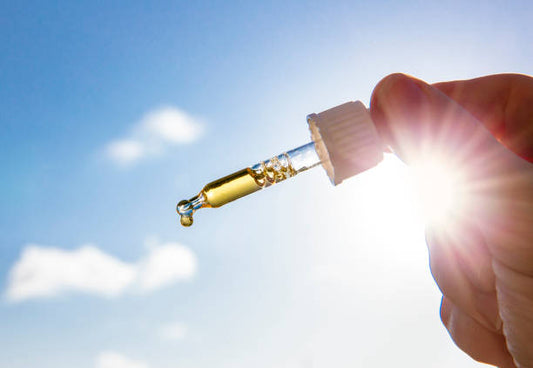Discover Related Products
Now explore supplements designed to support Longevity, Gut Health & Cellular Vitality.
CITOZYM - Support Natural Detox, Immune and Longevity Support
The Water We Drink: Everything You Need to Know About Its Characteristics, Pollutants, Solutions, and Benefits for Your Health

Water is essential for life and health. It makes up a significant portion of our bodies and is crucial for many biological processes. This article explores the characteristics of drinking water, common pollutants, scientific research on these topics, strategies to reduce contamination, and the benefits of water for our bodies.
Characteristics of Drinking Water
Ideal drinking water should be clear, colorless, and tasteless. It should have a pH between 6.5 and 8.5, moderate hardness, and be free from harmful substances like nitrates, heavy metals, and volatile organic compounds (VOCs). Additionally, it must be free from bacteria, viruses, and protozoa that can cause diseases.
Pollutants in Drinking Water
Unfortunately, the water we drink can contain various pollutants. Here are the most common ones:
1. Heavy Metals
- Lead: Comes from old pipes and building materials. It can cause neurological and kidney damage (1).
- Mercury: Released from industrial activities and mining. It is neurotoxic and can damage the nervous system (2).
- Arsenic: Naturally present in some groundwater and used in some pesticides. It can cause cancer and cardiovascular problems (3).
- Cadmium: Derives from fertilizers and industrial processes. Toxic to the kidneys and bones (4).
2. Pesticides and Fertilizers
- Atrazine: A widely used herbicide. It can interfere with the endocrine system (5).
-
Nitrates: Come from agricultural fertilizers. High levels can cause methemoglobinemia in infants (6).
3. Pathogenic Microorganisms
- Escherichia coli (E. coli): Indicator of fecal contamination. It can cause diarrhea and severe infections (7).
- Giardia lamblia: A protozoan that causes giardiasis, an intestinal illness (8).
- Norovirus: Causes viral gastroenteritis, with symptoms like vomiting and diarrhea (9).
- Origin: Derive from the degradation of plastic products and can be present in drinking water (10).
- Health Impact: Long-term effects on the human body are still being studied (11).
Scientific Research on Pollutants
Numerous studies have investigated the effects of pollutants on drinking water and methods to reduce them. For example, research has shown how lead in old pipes can contaminate water and the importance of replacing them (1). Studies on mercury have linked long-term exposure to significant neurological problems (2).
Regarding pesticides, an article demonstrated the negative impact of atrazine on aquatic fauna and potential endocrine interference in humans (5). The presence of nitrates in drinking water has been linked to increased risks of gastrointestinal cancer (6).
Studies on pathogenic microorganisms, like those conducted on E. coli, have highlighted the importance of proper water treatments to prevent infections (7). The presence of microplastics is also a growing concern and subject of research (10).
Solutions to Reduce Pollutants
1. Filtration
-
Activated Carbon Filters: Effective in removing pesticides, chlorine, and organic compounds. A study demonstrated their effectiveness in improving water quality (12).
-
Reverse Osmosis: Highly effective in removing heavy metals, nitrates, and other contaminants (13).
2. Chemical Treatments
-
Chlorination: Used to eliminate pathogenic microorganisms. However, it is essential to monitor disinfection by-products to avoid health risks (14).
- Ozonation: An alternative disinfection method that avoids forming harmful by-products (15).
- Sustainable Agricultural Practices: Reducing the use of pesticides and fertilizers can prevent contamination of water sources (16).
Benefits of Water for the Human Body
Water is crucial for many bodily functions:
-
Regulating Body Temperature: Through sweating and evaporation, water helps cool the body.
-
Transporting Nutrients and Oxygen: Blood, which is over 90% water, transports nutrients and oxygen to cells and removes metabolic waste products.
-
Eliminating Toxins: Water is essential for kidney function, facilitating the elimination of toxins through urine.
-
Lubricating Joints: Synovial fluid, which lubricates joints, is primarily composed of water.
-
Aiding Digestion and Nutrient Absorption: Water is a key component of digestive juices and helps dissolve and absorb nutrients in the digestive system.
-
Maintaining Blood Volume and Pressure: Water helps maintain plasma volume, directly influencing blood pressure and tissue perfusion.
The amount of water needed varies based on age, sex, physical activity level, health status, and environmental conditions. Generally, the guidelines from the World Health Organization (WHO) and the Institute of Medicine (IOM) recommend about 2.5 liters per day for men and about 2 liters per day for women (17). Children and adolescents have varying needs, while older adults should pay more attention to hydration as the sensation of thirst can decrease with age.
Health Benefits of Drinking Water
Water offers numerous health benefits:
-
Improving Physical Performance: Proper hydration is essential for
maintaining high physical performance, preventing fatigue, and improving endurance. -
Supporting Cognitive Functions: Hydration positively affects
concentration, short-term memory, and alertness (18). -
Preventing Kidney Stones: Adequate water intake helps dilute urine,
reducing the risk of kidney stone formation (19). -
Promoting Skin Health: Water helps keep the skin hydrated, improving elasticity and reducing the appearance of wrinkles and aging signs.
- Weight Management: Drinking water before meals can promote a sense of fullness, helping control calorie intake and promoting weight loss (20).
Conclusion
Safe drinking water is essential for public health. Scientific research continues to provide valuable data and innovative solutions to address the challenges of water contamination. Reducing pollutants through filtration methods, chemical treatments, and sustainable water resource management can significantly improve drinking water quality. Moreover, water performs numerous vital functions for the human body, making adequate hydration crucial for overall well-being and health.
References
- Levin, R., et al. (2008). Lead Exposures in U.S. Children, 2008: Implications for Prevention. Environmental Health Perspectives, 116(10), 1285-1293.
- Yokoo, E. M., et al. (2003). Low level methylmercury exposure affects neuropsychological function in adults. Environmental Health: A Global Access Science Source, 2, 8.
- Smith, A. H., et al. (2002). Arsenic in drinking water. Environmental Health Perspectives, 110(Suppl 1), 45-56.
- Satarug, S., et al. (2003). Cadmium, environmental exposure, and health outcomes. Environmental Health Perspectives, 118(2), 182-190.
- Hayes, T. B., et al. (2011). Demasculinization and feminization of male gonads by atrazine: Consistent effects across vertebrate classes. The Journal of Steroid Biochemistry and Molecular Biology, 127(1-2), 64-73.
- Ward, M. H., et al. (2005). Drinking-water nitrate and health—Recent findings and research needs. Environmental Health Perspectives, 113(11), 1607-1614.
- Hunter, P. R. (2003). Climate change and waterborne and vector- borne disease. Journal of Applied Microbiology, 94, 37S-46S.
- Adam, R. D. (2001). Biology of Giardia lamblia. Clinical Microbiology Reviews, 14(3), 447-475.
- Lopman, B. A., et al. (2003). Two epidemiologic patterns of norovirus outbreaks: surveillance in England and Wales, 1992-2000. Emerging Infectious Diseases, 9(1), 71-77.
- Thompson, R. C., et al. (2004). Lost at sea: where is all the plastic? Science, 304(5672), 838.
- Smith, M., et al. (2018). Microplastics in seafood and the implications for human health. Current Environmental Health Reports, 5(3), 375-386.
- Kim, S. D., et al. (2007). Occurrence and removal of pharmaceuticals and endocrine disruptors in South Korean surface, drinking, and waste waters. Water Research, 41(5), 1013-1021.
- Werber, J. R., Osuji, C. O., & Elimelech, M. (2016). Materials for next-generation desalination and water purification membranes. Nature Reviews Materials, 1(5), 16018.
- Richardson, S. D., et al. (2007). Water analysis: emerging contaminants and current issues. Analytical Chemistry, 79(12), 4295-4324.
- Von Gunten, U. (2003). Ozonation of drinking water: Part I. Oxidation kinetics and product formation. Water Research, 37(7), 1443-1467.
- Postel, S. L. (2000). Entering an era of water scarcity: The challenges ahead. Ecological Applications, 10(4), 941-948.
- World Health Organization. (2004). Guidelines for drinking-water quality. Vol. 1, Recommendations. Geneva: WHO.
- Popkin, B. M., D’Anci, K. E., & Rosenberg, I. H. (2010). Water, hydration, and health. Nutrition Reviews, 68(8), 439-458.
- Curhan, G. C., Willett, W. C., Knight, E. L., & Stampfer, M. J. (2004). Dietary factors and the risk of incident kidney stones in younger women: Nurses' Health Study II. Archives of Internal Medicine, 164(8), 885-891.
- Dennis, E. A., Dengo, A. L., Comber, D. L., Flack, K. D., Savla, J., & Davy, B. M. (2010). Water consumption increases weight loss during a hypocaloric diet intervention in middle-aged and older adults. Obesity, 18(2), 300-307.







No comments